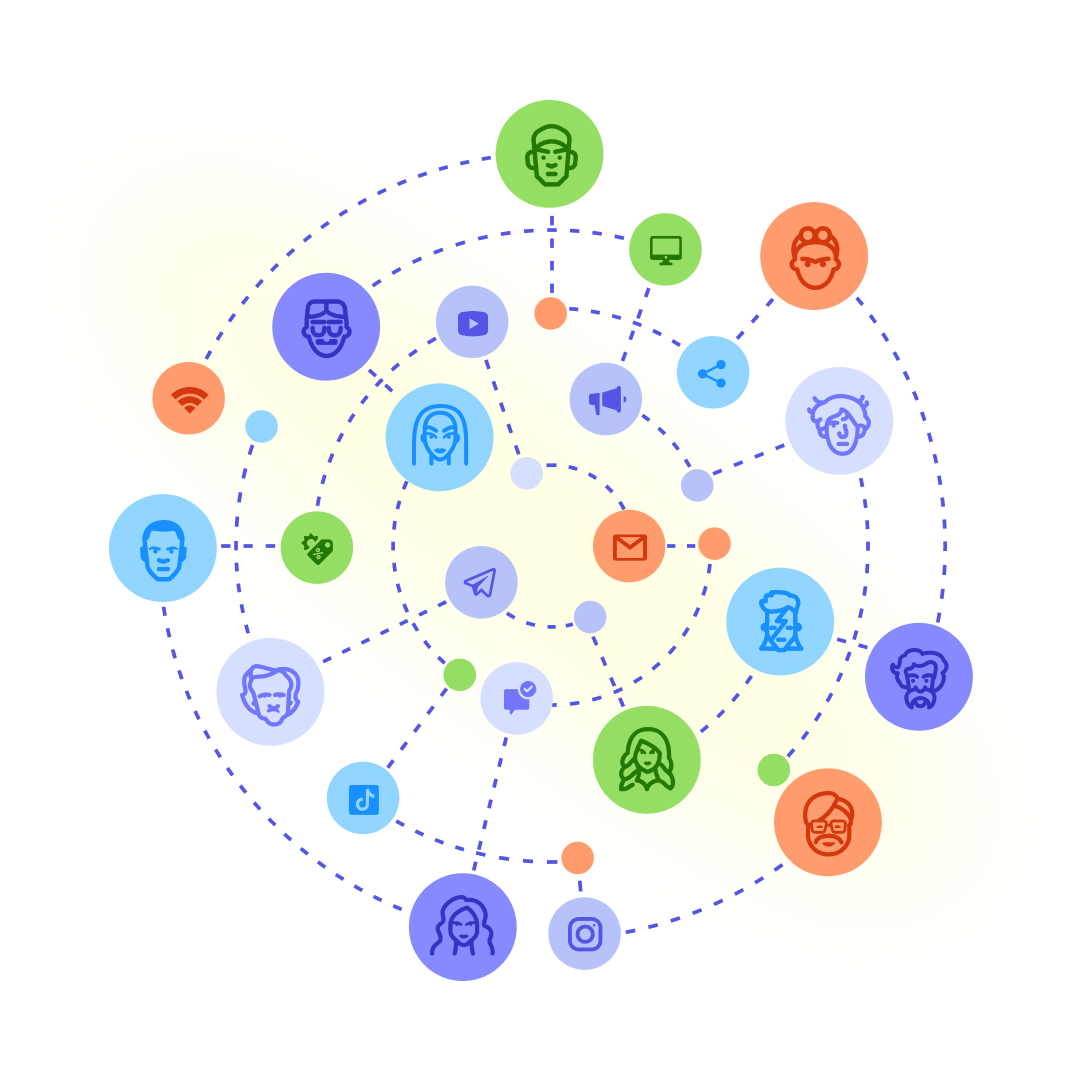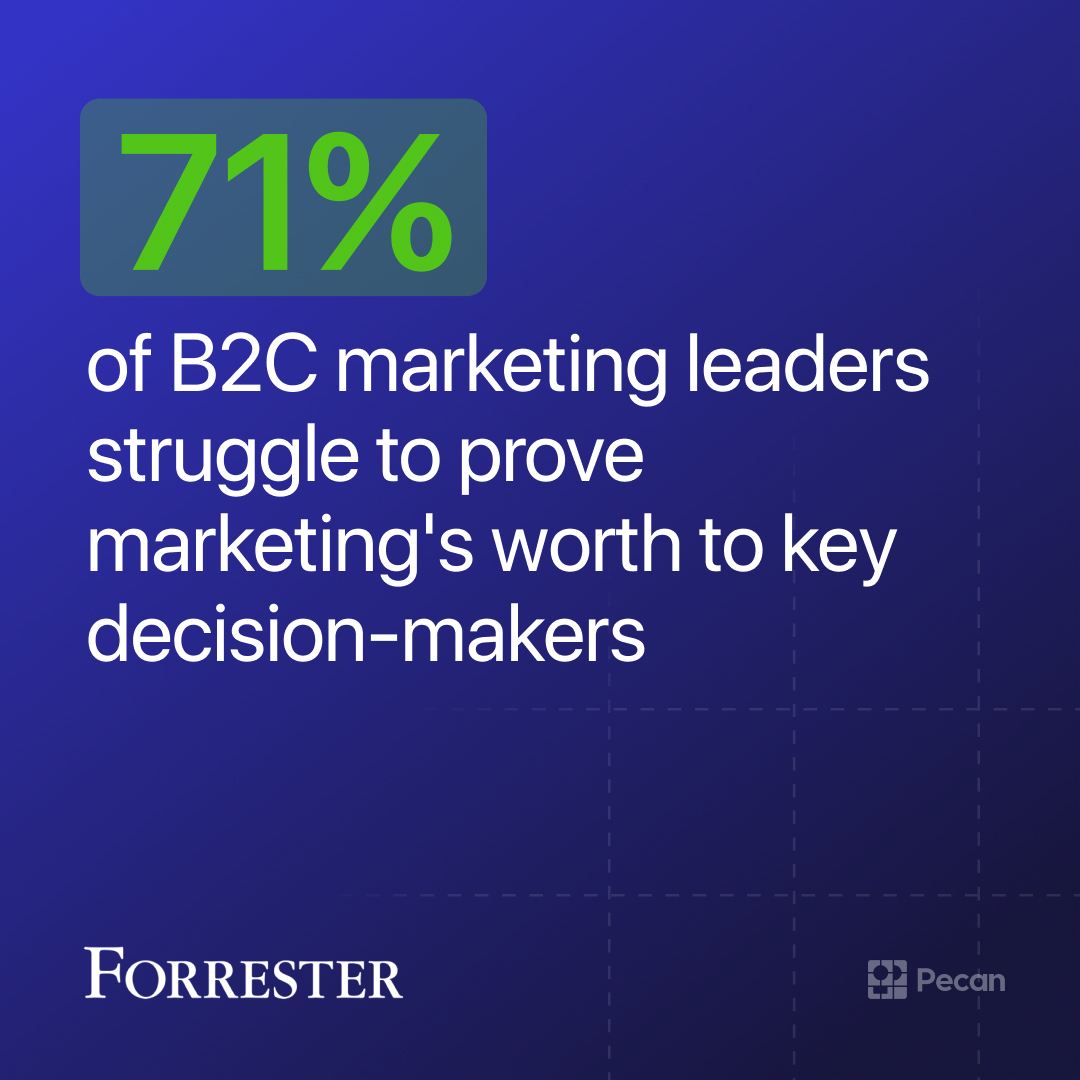In a nutshell:
- Many B2C marketing leaders struggle to prove marketing's worth to key decision-makers.
- Attribution models oversimplify the customer journey and may not accurately track engagement.
- The evolving customer journey and the downfall of third-party cookies further impact attribution's effectiveness.
- Building brand equity and using qualitative data alone are not sufficient alternatives to measurement and attribution.
- Marketing mix modeling (MMM) provides a top-down perspective that complements attribution data and offers a more holistic view of marketing performance.
If you’ve ever wondered whether your marketing efforts are making an impact, you’re not alone. According to a 2022 Forrester report, 71% of B2C marketing leaders struggle to prove marketing's worth to key decision-makers like the CEO, CFO, and the board. Attribution remains the go-to method for measuring marketing performance today, but it may not be as effective as its reputation suggests.
Attribution models tend to oversimplify an increasingly complicated customer journey and can fail to properly track complex interactions across channels. In addition, the imminent downfall of third-party cookies and new data privacy policies will further impact attribution’s ability to accurately track engagement and the success of different approaches to advertising.
So what alternatives do marketers have? In this blog, we explore the strengths and weaknesses of marketing attribution and discuss other analytic methods that can help enhance your marketing campaign performance.
Understanding marketing measurement and attribution today
Measurement and attribution are two key concepts in the field of marketing and advertising. Measurement refers to the process of quantifying the impact and effectiveness of marketing campaigns and activities. Measurement tools collect and analyze data to determine the outcomes and results of these efforts.
At its core, marketing attribution involves assigning credit to various milestones throughout the customer's journey, tracking key interactions that likely contributed to a conversion. These insights give marketers a repeatable method to measure the effectiveness of touchpoints and assets.
Measurement and attribution techniques are closely related because they aim to understand marketing efforts' impact. Measurement provides the data and insights needed to evaluate the success of campaigns, while attribution helps to identify which specific touchpoints or channels are driving the desired outcomes.
In digital marketing, measurement and attribution have become even more critical. With the ability to track and analyze user behavior across multiple channels and devices, marketers can gain a deep understanding of how different touchpoints contribute to conversions. This allows them to optimize their marketing strategies and allocate resources more effectively.
Attribution modeling approaches vary in approach and complexity, each shedding light on a different facet of the customer journey. (As a refresher, here’s a brief overview of several types of attribution models, like first-click models and time-decay models.)
If you’ve been in the marketing game for a while, you've likely crossed paths or used a mix of several of these. While these models effectively give marketers a standardized way of measuring performance, they’re not equipped to give you a bird’s eye view of the entire customer journey. And it only gets trickier the further down the rabbit hole you look.
The evolving, topsy-turvy customer journey and its effects on measurement and attribution
An unexpected outcome of the pandemic is customers' increased comfort level with engaging companies through phone calls, chats, and texts. Consumers might start researching a product on their mobile device, continue on a desktop computer, and ultimately purchase in-store.
The typical customer journey is increasingly non-linear and, therefore, much less predictable than it used to be, and many companies have yet to design customer-centric marketing performance models that capture this new sales funnel's reality.
-

- Today’s customer journeys are complex and involve a wide range of touchpoints — making attribution tougher than ever.
As Gene Cornfield explained, “This democratization of new interaction channels has made it more important that customer journeys not be rigidly tied to specific touchpoints. For example, a customer journey that portrays a linear series of interactions — customer sees offline ad, then goes to search engine, then is directed to landing page on website, then is retargeted on Facebook, then comes back to website and provides email address, after which an email to customer is triggered, etc. — is only useful as an example of what could happen if all the stars aligned — or if customers were willing to follow the script.
“But customers don’t follow scripts. They follow impulses, urges, whims, and preferences, often in unplanned moments of opportunity. So it’s important that journeys are not aligned to specific touchpoints according to what the company wants to happen. Rather, the company should seek to understand the series of need-points customers traverse in order to make decisions that achieve whatever outcome they ultimately intend.”
Many marketers still rely on predefined touchpoints that fit the established methods they’ve been using for years. For instance, the widely used “last-touch” attribution model only assigns credit to the last touchpoint on the path to conversion, oversimplifying the customer journey and not offering a granular understanding of audience attention and conversion paths.
Without capturing the intricate nuances of how customers interact with brands today, companies may be developing an out-of-touch understanding of customer behavior — leading to suboptimal marketing initiatives and campaigns.
Cross-channel tracking — how customers evade measurement and attribution
Your brand likely uses diverse channels to engage with its target audience — social media platforms, search engines, phone games, billboards, print ads, email campaigns, and more. Modern consumers are swiping and clicking around these platforms, paying more attention to various media channels than others.
You'll need to quantify numerous touchpoints' influence to achieve campaign success and your marketing goals. That's complicated. Attribution is most effective for digital marketing efforts, and it loses efficacy (and practicality) when incorporating multiple offline marketing channels into an optimal media mix.
Cookies for measurement and attribution: helpful, sweet — gone
External factors have made it even more challenging to follow genuine customer journeys. Privacy regulations, such as GDPR and CCPA, limit user data access, making tracking and attributing interactions harder. Ad blockers and ad fraud further erode attribution accuracy by preventing tracking or generating false interactions. Changes in Apple's SKAdNetwork mean digital marketers now have to tweak their attribution strategies to fit within the limitations set by the system. Plus, marketers are facing the cookieless future, a critical step in the shifting measurement and attribution environment.
As a result, marketing and business decisions are often made with incomplete or inaccurate attribution data, hampering the ability to allocate resources optimally. These complexities and challenges are not unique to a single marketing team; they resonate throughout the industry.
With these hurdles in mind, modern marketers need to explore alternative strategies to future-proof their programs.
Some alternatives to measurement and attribution we wouldn't recommend
Simply focus on building brand equity
Some argue that measurement and attribution are overrated in marketing. These folks suggest that businesses should prioritize building a strong brand image rather than investing heavily in measuring and attributing the impact of their marketing efforts. This perspective would say that simply having a powerful brand would outweigh the need for precise measurement and attribution of specific marketing activities.
While building your brand is always important, marketing measurement and attribution are still essential for providing accountability, optimizing resources, adapting to changing market dynamics, gaining valuable customer insights, and offering tangible proof of campaign effectiveness. Instead, consider a balanced approach that integrates both building brand equity and rigorous measurement practices with reliable insights.
Qualitative data and feedback from customers are enough
In reality, there's a harmonious relationship between quantitative and qualitative insights in marketing. Qualitative customer insights are invaluable in understanding the human aspect of consumer behavior. But quantitative metrics provide a necessary basis for resource optimization and data-driven decision-making.
If you completely disregard measurement, you'll miss out on valuable insights into the effectiveness of campaigns, won't spot market changes in advance, and will probably struggle to demonstrate the tangible impact of marketing efforts. Again, it's all about the balance — combining quantitative and qualitative information means you'll have a comprehensive understanding of consumer behavior and a stronger foundation for marketing success.
Just go real-time and optimize on the fly
Finally, some propose that marketers should shift towards real-time data analysis and optimization. That might sound tempting, but it's worth taking a closer look. Real-time data is fantastic for quick adjustments, no doubt. But completely sidelining measurement and attribution could mean missing out on the bigger picture – understanding what's really driving your success and where you might need to fine-tune your media mix planning and budget allocation.
It's like having both a GPS for real-time navigation and a map for the overall journey. Both have their strengths, and a mix might just be the sweet spot for steering your marketing efforts in the right direction.
Exploring alternative marketing performance measurement approaches
Measurement and attribution are still critical, it seems, so how can you best get a handle on the quantitative side of marketing performance?
There are many successful approaches to measuring marketing performance that aren’t hindered by data privacy changes that can also quantify the modern customer journey. Now that artificial intelligence (AI) is changing virtually every industry and solution (and domain name), it’s reasonable to wonder if there's a more effective way to tackle marketing analytics.
One future-proof solution is marketing mix modeling (MMM), which provides a top-down perspective on all channels that complements insights from user-level attribution data.
Built to inform data-driven decision-making about marketing effectiveness, MMM measures incrementality, revealing the real value and impact of different channels, online and offline. While MMM is a statistical model that businesses have used for decades, automated machine learning has amped up what MMM can do to provide much faster, more accurate, and actionable insights about ad spending.
Unlike attribution, MMM provides invaluable insights into resource allocation across marketing channels without solely relying on user activity data. With a bird’s eye view, marketing leaders can showcase the cumulative impact of their efforts.
And MMM doesn’t have to be your only tracking method. Attribution and MMM can be used together to drive data-driven investment decisions. While attribution offers a bottom-up optimization of campaigns based on user-level data, MMM steps in with the top-down perspective that covers every channel and helps you better understand return on ad spend.
By blending these insights, you create the foundation for a holistic view and an analytics strategy that empowers your marketing team amid complex customer journeys and platform policy changes.
Reimagine your marketing analytics
As we reflect on the challenges of marketing attribution, one thing is abundantly clear: The traditional practice of assigning credit to distinct touchpoints falls short in addressing the growing complexities of the modern customer journey. Attribution, although prevalent, now appears oversimplified.
Reconnecting with how customers explore and develop affinity for brands holds the key to crafting campaigns that delight them throughout their journey. By focusing on customers — while still tracking channel and campaign effectiveness — marketers can connect with customers on their terms. They can measure effectiveness and adapt to customer preferences within this ever-evolving digital transformation landscape.
As you look to track campaign performance, it’s time to shift to a more customer-centric, data-driven approach for long-term success.





